Cloud vs On-Premises: Machine Learning Pros and Cons
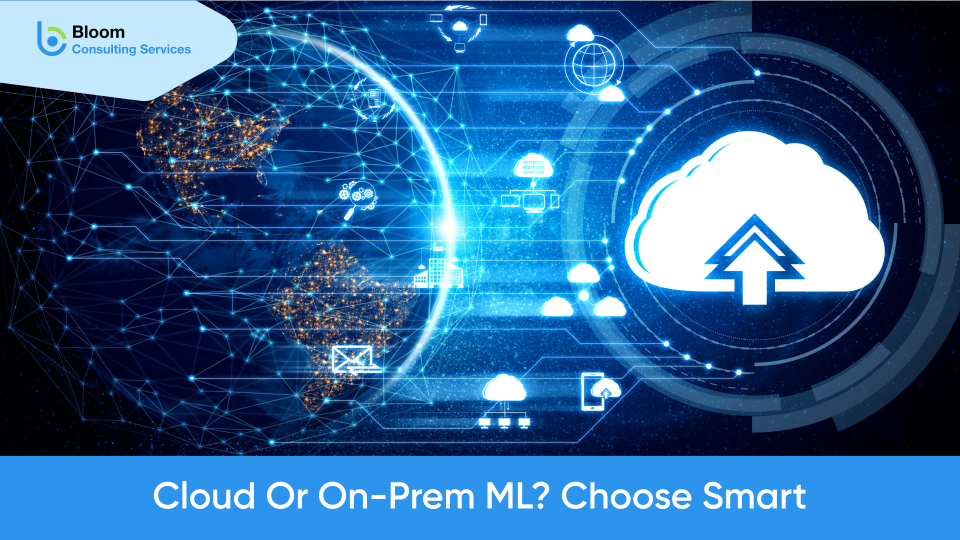
In the fast-evolving digital landscape of today, machine learning remains at the very heart of modern applications harnessed for business automation, analytics, and smarter decisions. However, with more ML solutions being adopted, organizations wrestle endlessly with one question-that is, Cloud vs On-Premises, which platform is better used to deploy machine learning models.
Each cloud and On-Premises ML alternative have its benefits and trade-offs. Cloud-based ML ensures scalability, speed and deployment, and access to latest tools, while On-Premises solutions ensure complete control over data, infrastructure, and security. It’s not just a technical choice to choose between the two; it’s also a strategic one that is affected by cost, compliance, performance, and extended walk-away.
This blog looks at Cloud vs On-Premises ML from every angle and takes an honest look at the merits and cons of each. We will look at important elements like deployment and maintenance, data privacy and latency, as well as new trends like hybrid ML frameworks. If you are a business decision-maker or an ML practitioner, knowing the differences between these can help you choose the right one for your purposes.
Hence, deep dive into this clash between Cloud and On-Premises ML and discover what truly distinguishes both options.
Table of Contents
Introduction to Machine Learning Solutions
Machine learning transforms how organizations operate, analyze data, and engage with customers. Pattern detection, task automation, and generation of insights are functions that make ML applications versatile in nature across industries. Yet, an ML initiative can only be successful when there is a strong need for model deployment in Machine Learning and where one would consider deploying it. Thus arises the great dilemma: Cloud Machine Learning vs On-Premises Machine Learning? The selection of the environment will make an impact on anything from performance to cost, scalability, and data control. Let’s delve into the foundations of machine learning solutions and why deployment strategy is important.
What Are Machine Learning Solutions?
Machine learning solutions mean end-to-end systems for data-driven automation and decision-making. This includes data-pipelines, model training tools, deployment platforms, and monitoring frameworks. Commercialized or interned, the end goal is to build models based on real-world problems in an efficient manner. Cloud vs On-Premises Machine Learning deployment will guide how flexible, secure, or cost-effective these solutions can be. Getting the right choice will immensely impact businesses.
Why Deployment Environment Matters
Performance and efficiency of the ML model highly depend on the underlying infrastructure. Cloud environments are scalable and generally host a managed service worthy for quickly deploying solutions. An On-Premises facility is set up to provide more control on data and hardware, critical in regulated industries. One cannot consider any On-Premises vs Cloud decision without also factoring in compliance, security, and cost. Each infrastructure has its own paradigms, advantages, and shortcomings.
Strategic Factors Affecting Deployment Decisions
Cost structures, latency, data privacy, and resource availability are factors weighing on a decision. Cloud providers reduce the upfront investments required, while some accrue the long-term notion of a subscription fee. On-Premises solutions entail much initial cost but mark expenses with the sticker of ownership in a foreseeable way. In essence, a Cloud vs On-Prem ML Solutions debate is more about aligning an infrastructure with business strategy. The best choice will be one that gives good market performance and substantial returns on an investment.
Flexibility Increasingly Needed
While ML deployment is on the rise, companies need to have flexible deployment strategies to keep up with changing demands. Some may start off in the cloud for ease of use then opt for On-Premises for data control. Others may take the hybrid approach. Whichever way, the Cloud Machine Learning vs On-Premises Machine Learning decision now influences how agile and scalable one ends up getting over a long period. Hence, flexibility is now becoming an important facet for how ML solutions get designed and deployed.
What is Cloud-Based Machine Learning?
Cloud Machine Learning is the set of services and infrastructure through which organizations build, train, and deploy ML models in the cloud. This model means there is no need to maintain On Premises servers or storage; instead, one rents access to immense computational powers flexibly, on a pay-as-you-go basis. State-of-the-art tools? Scaling up in no time? Try-and-error at low stakes? That is exactly what cloud platforms like Azure, AWS, and Google Cloud have injected into mainstream existence. Going by convenience and scalability, cloud ML only accounts for the topmost positions in deployment choices over the course of an enterprise considering Cloud vs On-Premises deployment.
Key Features of Cloud-Based ML
Cloud ML platforms make reintegrated environments available to data scientists and ML engineers. These environments offer tools for data preparation and model training, validation, and deployment—all available via a browser interface. Services such as AutoML, duly managed notebooks, and MLOps pipelines lay smooth avenues to good workflows. In the oft-discussed topic, this preloaded options offer simplicity and save time. In simpler words, Cloud ML smoothens the whole way of working for teams of any size.
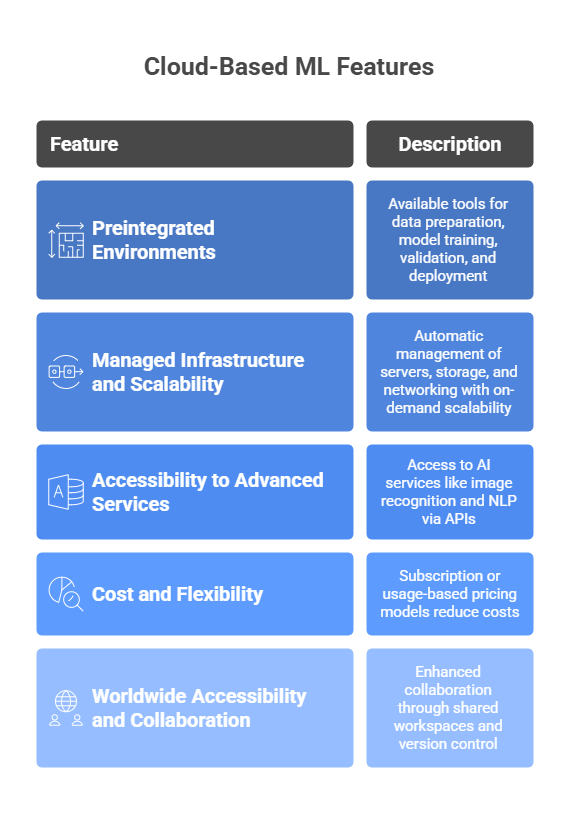
Managed Infrastructure and Scalability
With cloud platforms, the management of servers, storage, and networking is done automatically, leaving the developers free to concentrate on model development. It offers on-demand scalability, so resources could morph to either up or down depending on the workload. It finally comes handy when big models need to be trained or when big spikes in data processing need to be handled. Comparing Cloud Machine Learning vs On-Premises Machine Learning, cloud scalability is swift, and it is efficient. It allows teams to scale with zero technical overhead.
Accessibility to Advanced Services
The big cloud providers provide AI services such as image recognition, natural language processing, and real-time analytics via APIs. These services allow a way for companies to apply ML in their applications without having to build everything from scratch. Considering Cloud vs On-Prem ML Solutions, usually, the cloud side would offer a wider reach to advanced features. This accelerates innovation while easing some pressure off in-house teams.
Cases of Cloud-Based ML
Cloud ML frees from large capital expenditures as hardware need not be purchased and maintained; thereby, cloud ML supports faster experiments, shared workflows, and integration with cloud-native tools. Also, cloud providers work continuously towards improving services and issuing patches for security. If Cloud vs On-Premises options are to be considered, the cloud provides a low-risk-high-return entry for businesses into ML. Truly, this set of perks, therefore, makes cloud solutions an attractive choice for a business intent on rapid innovation.
Less Cost and Flexibility
Cloud ML uses subscription or usage-based pricing models, so companies reduce costs efficiently. It requires no data centers that almost empty your pockets; instead, expenses are incurred on actual usage of Cloud ML. Businesses may commence with smaller size scaling later with need, thereby resolving uncertainties over financial risks. Indeed, this flexible cost structure probably has tipped scales in favor of the cloud. It makes it easier for companies to strategically allocate resources.
Worldwide Accessibility and Collaboration
Different-location-based teams would use cloud ML platforms to enhance collaboration, hence productivity. Cloud environments would provide shared workspace, versioning control, and instant updates. This is particularly good for global companies with distributed data teams. Comparing Cloud vs On-Premises, the cloud greatly allows for smooth cooperation. Cloud collaboration tools fix workflows across time zones.
Stay ahead with AI—start your journey today
Limitations of Cloud ML
All of it has advantages but cannot fit in certain scenarios. Relying on internet connectivity, sovereignty concerns, time subscription costs could discourage certain organizations. Cloud ML perhaps makes it even harder for an industry with certain strict compliance rules. These limitations require a strict strategic approach. Cloud ML is not really suited to anything and everything.
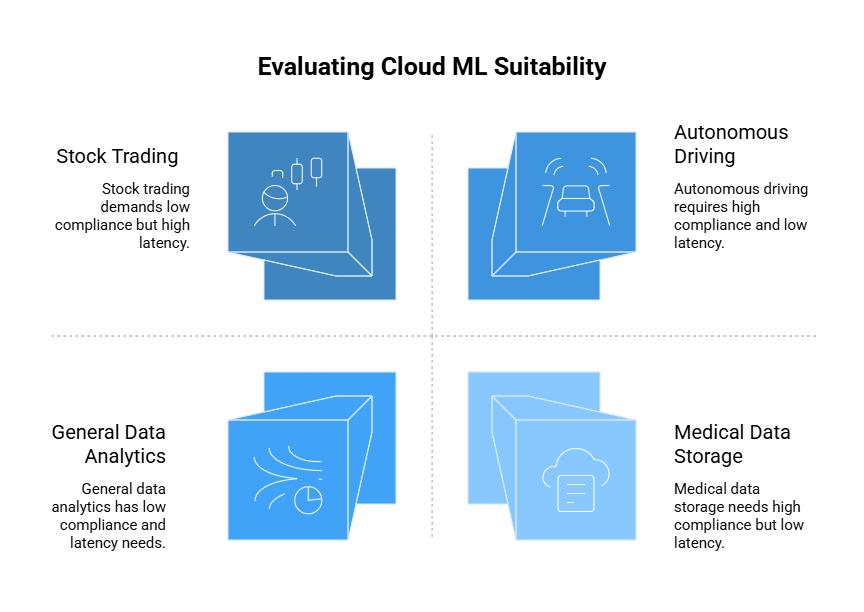
Latency and Network Dependency
Adequate and stable internet connection is required by Cloud ML to carry out operations like data transmission and model management. Latency may pose a serious problem, especially when used for real-time use cases like autonomous driving or stock trading. If the network goes down, ML stops. In contrast with Cloud vs On-Premises, latency becomes a disadvantage for the cloud. For time-sensitive tasks, an On-Premises setup can actually feel faster.
Data Privacy and Compliance Risks
Storing sensitive data in the cloud might pose certain regulatory issues, in case this data pertains to medical or financial domains. Some countries’ regulations require their data to be retained inside national borders, thus making cloud storage a risky proposition. This puts the concerned consideration at the forefront for any data-sensitive project. Thus, organizations must ask themselves whether they can operate in the cloud, given their compliance needs.
When Cloud ML is the Right Choice?
It implies that ML on Cloud is good for businesses that demand quick deployment, flexibility, and less infrastructure management. It is best suited for organizations in the early stages of learning ML, trying to prototype, or growing fast. ML on the cloud, for a non-sensitive app, makes development faster and less costly. Agility and innovation are areas where cloud wins over On-Premises. Let’s look at some scenarios where cloud ML shines.

Great for Startups and SMBs
Startups and small businesses generally cannot afford to build or maintain an on-prem infrastructure. Using Cloud ML, however, they get access to high-end tools without heavy costs upfront. This levels the playing field allowing for innovation to occur at a much lower cost. In Cloud vs On-Premises, the cloud just provides a low-barrier entry point for small firms to compete with large players.
Best for Rapid Prototyping and Scaling
Cloud ML favors quick experimentation, allowing teams to develop, test, and iterate models faster. As soon as a model behaves well in production, scaling it becomes instant, removing the need to upgrade any hardware. This supports agile development cycles and faster market entry. Therefore, the cloud is best for projects that need to move fast. It allows teams to innovate at that pace.
What is On-Premises Machine Learning?
On-Premises ML thus means building, training, and executing ML models on an organization´s own infrastructure-the servers dedicated to it, the On Premises storage, the private network, and so on. Machinery-learning is carried out by some organizations that desire control, security, and compliance issues. It is an on-prem solution, whereas cloud-based ones would be run by service providers externally. On-prem is more autonomy but more responsibilities in maintenance in the Cloud vs On-Premises comparison.
Key Features of On-Premises ML
In On-Premises systems, companies gain the ultimate control of their hardware and software environments. The infrastructure can be designed keeping in mind those specific requirements of performance, security, and compliance. The On-Premises setup usually integrates with existing enterprise-level systems, creating a highly customized AB approach to ML deployment. The former is ideal for mission-critical workloads. In reality, its primary selling point is control-compliance.

Customized Infrastructure
Organizations have options to choose their hardware, configure their network systems, and manage their resources according to their needs. This leads to predictable performance and security. On-Premises setups can be fine-tuned for latency-sensitive applications. On-Premises vs Cloud differentiates hugely on this basis. That allows businesses to tailor-make systems to operate at highest efficiency.
Full Control Over Data
In On-Premises ML, data either lies within the organization’s physical premises or is in its private cloud. This gives the organization freedom and concerns about third-party access. It is, thus, great for very confidential or heavily regulated information. In the Cloud vs On-Premises battle, On-Premises is ahead with data ownership wherein organizations regulate access policies on their own.
Benefits of On-Premises ML
Maximizing one’s control over security, privacy, and systems is possible only with On-Premises ML. This allows organizations to comply with data laws and not have to depend upon public internet. From the perspective of a long-duration undertaking, having its infrastructure could turn out to be more cost-effective compared to subscribing to the cloud. For On-Premises vs Cloud, On-Premises wins out for privacy and long-term cost distributions: It is a popular choice in highly regulated industries.

Improved security and compliance
On premises are most suitable for industry sectors where severe compliance requirements are necessitated, such as healthcare, defense, and finance. The data never enters the external network, minimizing threats from external forces. Hence, complying with laws like HIPAA, GDPR, or CCPA becomes relatively easier. In Cloud vs On-Premises, security usually tops the most important factors. On-Premises ensures that the level of control put on sensitive assets is very high.
Predictable long-term costs
When considered over an extended period, capital expenditure begins to matter less. Whereas, considering only discount costs, while additional improvements are made to the capital goods or installing them in series significantly increases initial investment costs, operational costs remain relatively low and predictable with no further subscription fees to surprise charges, thus providing ease in budgeting and planning of resources. In On-Premises vs Cloud, long-term ML commitment brings attractiveness to On-Premises, where ownership equals financial predictability.
Limitations of On-Premises ML
Despite its advantages, On-Premises ML does present quite a number of challenges. Among the typical hurdles found On-Premises are high setup costs, low scalability, and the need for a great deal of technical expertise. It requires time and resources to maintain and improve the environment. It is these very limitations that sometimes slow down innovation. Hence, businesses are given the option of either choosing control or complexity.
Capital Investment and Maintenance Costs
Setting up servers, storage, networks, etc., requires huge capital investment. Operating and maintenance costs will include energy consumption and staffing of IT personnel. This may be prohibitive to SMEs. In Cloud vs On-Premises, costs can be an entry barrier. The On-Premises ones favor the bigger enterprises capable of bearing such expenses.
Scalability Issues
Scaling an infrastructure with demands for ML growth translates to more hardware purchases, which consumes time and money. A slower and more sluggish reaction would then take place amid sudden workload changing scenarios. Resources need an instant allocation in the cloud; however, it is not so with On-Premises. In On-Premises vs Cloud, limited scalability is offered On-Premises. Businesses must plan growth well ahead of time.
When On-Premises ML is the Right Choice?
On-Premises ML solutions suit businesses dealing with sensitive data or those in highly regulated sectors. The option also suits companies with more or less stable workloads justifying an upfront investment. It is the choice to go for if you want total control over infrastructure and ownership long term. The point one prefers On-Premises in Cloud vs On-Premises is that in contrast to convenience, it offers control.
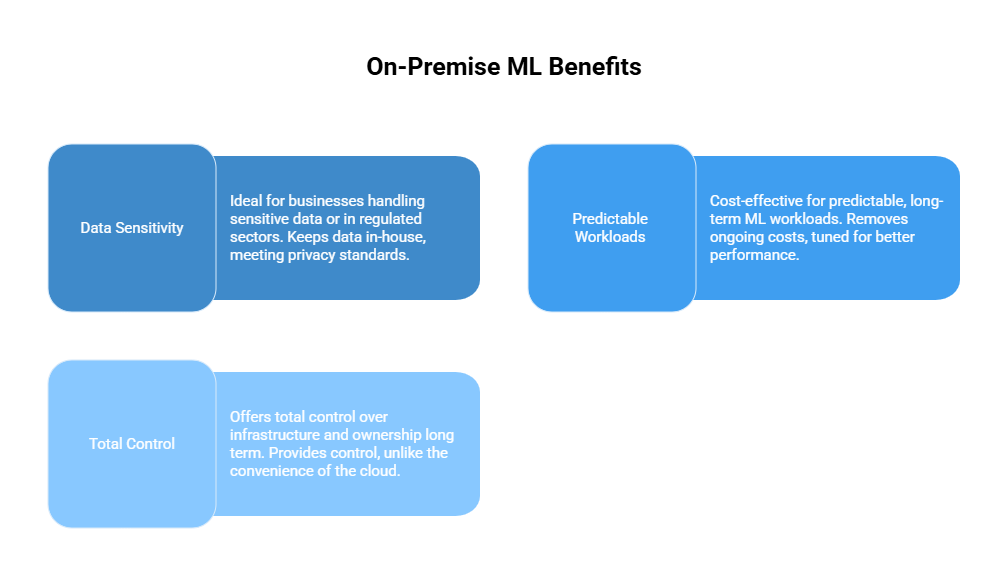
Ideal for Regulated Industries.
Industries like health, banking, and defense are to abide by strict laws pertaining to data privacy. On-Premises ML helps in keeping all the data in-house and meeting these standards. It, thereby, limits compliance risks and aligns with all regulatory requirements. Regulated industries mostly go for On-Premises, another safer idea in handling confidential data.
Best for Predictable Workloads
An On-Premises infrastructure is cost-effective when the ML workloads are predictable and long-term. They also remove the in-going costs, hence can be properly tuned for better performance. On-Premises works best for companies with steady ML use cases. On-Premises is suitable when workloads are predictable as it ensures consistent performance and ROI.
Cloud vs On Premises Machine Learning: Key Differences
Smith argues that the placement of the ML workload will be determined depending on the distinction between Cloud and On-Premises. Each environment offers unique advantages and drawbacks, depending on scale, data sensitivity, and performance requirements. Cloud Machine Learning emphasizes scalability, speed, and flexibility. However, On Premises Machine Learning emphasizes control, customization, and compliance. The choice between the two is subjected to careful consideration of technical and strategic factors. So let us investigate all the aspects that make up the decision to work in the Cloud or On Premises ML environment.
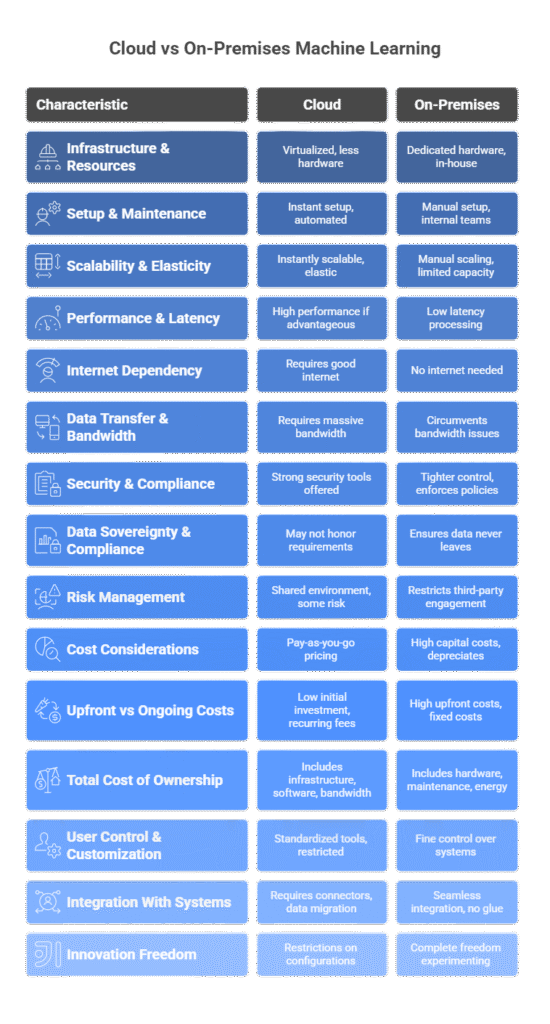
Infrastructure and Resource Management
Infrastructure remains the primary distinguishing factor between cloud and On Premises ML arrangements. Cloud platforms accomplish virtualization at their providers’ end; hence, the need for physical hardware is discarded. On Premises ML requires dedicated servers, storage, and maintenance in-house. Hence cloud reduces the overhead of management in Cloud vs On-Premises. The On Premises, on the contrary, has more IT investments and expertise.
Setup and Maintenance
Cloud ML can be set up almost instantly through managed services, reducing the time to deployment. Maintenance is automated in this setting; updates, scaling, and security patches. On Premises ML involves internal teams setting up and maintaining these manually. Therefore, the cloud feels much more convenient. On Premises means more work but total control.
Scalability and Elasticity
Resources in the cloud can scale up or down in an instant, and depending on demand, making it easy to handle workloads that keep fluctuating. Since On Premises infrastructure always has to be scaled manually, it most times requires new hardware, which would slow down reacting to growth or sudden spikes. In Cloud vs On-Premises, cloud is best for dynamic needs. Premises are limited by the capacity available.
Performance and Latency
It all depends on workload type and infrastructure capabilities. Cloud ML can provide higher performances if the internet speed and cloud server location are advantageous. On Premises ML comes with low-latency processing, especially when processing must be done in real time. Cloud vs On-Premises: this is where On Premises excels in latency-sensitive use cases, while the Cloud is deemed fit for the non-critical ones.
Internet Dependency
A good internet connection is an added requirement for Cloud ML to perform efficiently. Some network disturbances can hamper its performance and even cause downtime. On Premises ML needs no internet, and it does offer consistent uptime. Here, Cloud can be at a disadvantage because of the dependence on the internet for remote access; it is unlike On Premises, where you can continue to work even when the internet is down.
Data Transfer and Bandwidth
Transferring large sets of data to and from the Cloud requires massive bandwidth; that would entail expenses as well as delays. On Premises ML circumvents all this by performing the data processing On-Premises. In Cloud vs On-Premises, data-heavy projects may favor On Premises setups. The Cloud is known to have problems with moving data at large scales.
Security and Compliance
When deploying Machine Learning, security is topmost in consideration, especially in sensitive industries. Cloud providers may offer strong tools for security, yet the data resides on third-party infrastructure. On Premises ML, on the contrary, provides tighter control for enforcing security policies and granting access to data. Privacy-wise, On Premises is the winner in Cloud vs On-Premises. Cloud suits those environments where the regulations are lean.
Data Sovereignty and Compliance Laws
Certain industries and regions mandated data to be able to stay within boundaries. Cloud ML may not honor those requirements for data sovereignty. On Premises ML ensures that data never leaves the premises, hence aiding compliance. In Cloud vs On-Premises, compliance with regulations mostly drives the choice. On Premises gives stronger assurance on legal adherence.
Risk Management
Cloud being a shared environment, there remains some risk, even after encryption and safeguards. On Premises ML, however, restricts third-party engagement, thus reducing exposure. But threats can also arise from internal leaks or mismanagement. In Cloud vs On-Premises, risk rests on the implementation itself. Both environments require enforcement of sound security policies.
Cost Considerations
Cost considerations play a great role in decisions on deployment. Cloud ML offers a pay-as-you-go pricing model, thus minimizing upfront costs. On Premises ML depreciates more in capital costs under-the-radar; at times, it may, however, turn out less expensive in the long run for fixed workloads. Cost models change between Cloud and On-Premises. Both short- and long-term costs should be weighed by businesses.
Upfront Vs Ongoing Costs
Cloud ML permits low initial investment but incurs subscription/usage fees recurring/in the future. On Premises ML demands buying the hardware upfront, after which costs remain fixed. Cloud vs On-Premises: Cloud is best for short-term and variable projects; On Premises suits long-term and stable projects.
Total Cost of Ownership (TCO)
For Cloud, TCO includes infrastructure, software, bandwidth, and service fees; for the On Premises one, it’s all of hardware, maintenance, and energy. As time passes, TCO may become biased toward On Premises ML if you have steady workflows. In Cloud vs On-Premises, cost-effectiveness goes by usage patterns. Forecasting with accuracy is key.
User Control and Customization
Cloud platforms offer standardized tools and configuration, thereby restricting customization. On Premises ML provides very fine control over systems, workflows, and resource allocation. This is vital for specializers or a legacy application. In Cloud vs On-Premises, On Premises support customizations. Cloud stands for simplicity and speed.
Integration With Existing Systems
On Premises ML can be seamlessly integrated with existing On-Premises databases, applications, and networks. Cloud ML will require connectors or data migration, which poses added complexity. On the other hand, when compared in Cloud vs On-Premises, On Premises is better for integration since it requires no glue. Cloud is great for a new project that is run independently.
Innovation Freedom
On-Premises setups offer complete freedom in experimenting with unorthodox architectures or software. Clouds might have restrictions on certain configurations or access. In Cloud vs On-Premises, On Premises offer freedom for innovation. Cloud offers standardization with ease of use.
Turn AI trends into business success
Pros and Cons: Cloud vs On-Prem ML Solutions
To implement machine learning solutions, the choice must be made between cloud and On-Premises, weighing their respective pros and cons. On cloud ML, it is speed, flexibility, and less initial outlay that are the claims to fame; on the other hand, On-Premises ML can foster control, security, and By compliance control. Whatever pathway you choose would depend on which business goals you had to meet, wherein rests data sensitivity, and how long you intended the option to last. Having a good grasp of the Cloud vs On-Premises pros and cons provides the organization with a balanced view wherein they can opt for innovation or operational control. Let us see what each deployment approach has in store for us-the ups and the downs!
Pros of Cloud ML Solutions
With cloud offerings come speed, scalability, low entry barrier, etc. Companies easily execute their first projects; there is no need to purchase physical infrastructure. Faster experimentation and deployment come from managed services and the latest ML tools. Speed is one of the advantages of cloud computing compared to On-Premises. Let’s delve into its benefits:
Quick Setup and Deployment
Cloud ML environments are out-of-the-box, where they provide the necessary tools, APIs, and templates. Projects can be deployed within hours. This, of course, works well with time-sensitive applications or pilot projects. In Cloud vs On-Premises, the cloud equals time to value. Businesses can innovate now, with no delays in setting up.
Scalability and Resource Flexibility
Cloud Platforms provide the ability to scale up or down at a moment’s notice, depending on workload requirements. It allows resource scaling and management with ease, irrespective of whether the organization is training large models or receiving sudden data onslaughts seasonally. Dynamic scaling reduces over-provisioning for On-Premises vs Cloud; cloud takes the lead in elasticity. Organizations pay for what they use.
Access to Latest Technologies
Cloud providers keep services updated and offer the very latest ML tools, pre-trained models, and automation working for them. This is about enabling the faster uptake of new features without having too internally upgrade. In Cloud vs On-Premises, cloud provides the promise of constant innovation wherein the competition stays relevant with very little effort.
Cons of Cloud ML Solutions
Despite the strengths, cloud machine learning also has its shortcomings with dependence on connectivity and some security-related issues. Subscription charges may get exceedingly high with heavy usage and over a period of time. In On-Premises vs Cloud, cloud cedes control for convenience. Let us eye through the limitations.
Data privacy and compliance problems
In cloud storage, this can be risky for sensitive data, especially in regulated industries. Data residency, access control and third-party management may be of concern. In Cloud vs On-Premises, data-sensitive cases often shy away from cloud. Compliance may take precedence over cloud benefits.
Long-Term Cost Accumulation
Although low initial costs are charged, subscription and data transfer fees quickly climb. A cloud can become a far more thrilling option than On-Premises infrastructure in cost within a period. In On-Premises vs Cloud, operator cloud abandonment is a good short-track. Stable long-track work On-Premises might actually pay themselves back.
Pros of On-Premises ML Solutions
On-Premises Machine Learning allows complete control over infrastructure, data, and security. It is apt for industries to have regulations in place. It can fit ML workflows that are heavily customized. Organizations may thus optimize systems toward specific needs. From the perspective of Cloud vs On-Premises, On-Premises wins in the arena of privacy and performance. Let us take a look at the primary benefits.
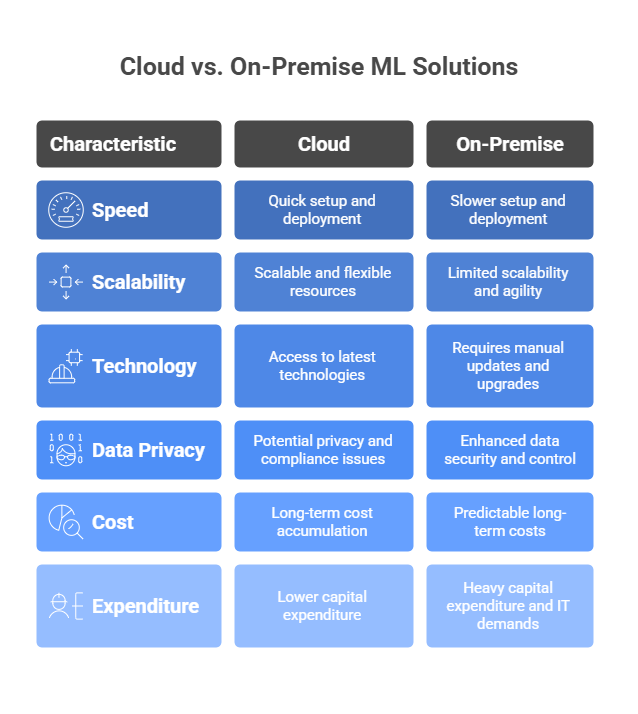
Enhanced Data Security and Control
All data remains within the organization’s own environment, minimizing outside threats. Custom security policies may be created and enforced, and data sovereignty upheld. So, in the battle of On-Premises vs Cloud, On-Premises stands tall on the fronts of data control, maximum privacy, and compliance.
Predictable and Lower Long-Term Costs
There is definitely an upfront investment; however, this cost remains steady as time passes. Given that there are no continuous cloud fees, On-Premises is apt to reduce the total cost of ownership for long-term works. Giving Cloud vs On-Premises thought, On-Premises rebounds with respect to cost predictability and would be suitable for a generally constant workload.
Cons of On-Premises ML Solutions
On-Premises ML necessitates a huge number of resources for setting up, maintenance, and scaling. This limits flexibility and might cause potential delays in time-to-market among ML initiatives. Hence, with Cloud vs On-Premises, control equals complexity. Let us consider its shortcomings:
Heavy Capital Expenditure and IT Demands
Hardware, software, and IT personnel must all be acquired to create and maintain On-Premises ML. Such costs can prove to be highly prohibitive for micro and small businesses. Therefore, with On-Premises vs Cloud, there is a higher entry barrier. It may be beneficial to enterprises that possess the required resources.
Limited Scalability and Agility
Purchasing, installing, and configuring additional hardware to provide more capacity always takes some time. That may cut down on agility and drop any responsiveness toward the ever-changing need. In Cloud vs On-Premises, On-Premises turns out to be less adaptive. Growth is something very hard to plan.
Deployment Considerations for Machine Learning Models
The other half of the victory is getting to deploy it. Deployment entails preparing the model to go into production, so it serves the real-world purpose. Successful deployment depends on factors such as infrastructure readiness, performance threshold, system integration. Organizations must consider those parameters while making a choice between Cloud or On-Premises deployment. Let us discuss everything that goes into training an efficient and reliable deployment system for machine learning models.
Key Stages of Machine Learning Model Deployment
Deploying ML usually sees multiple variables: testing, integration, scaling, and monitoring. These steps make sure the system is working as expected and delivering precise models in real-life environments. Each stage would need to be merged with business objectives as well as technical capabilities. Deployment in the complexity-versus-flexibility-conflict: On-Premises and Cloud-coming-back fare differently to each other on these criteria. Let’s look at these stages one by one.
Test and Validate
Before the actual deployment, the model must be tested extensively for accuracy, possible bias, and performance in varying conditions so that it can be trusted against real-time data in the outside world. Cloud platforms come with in-built tool sets for automated testing, whereas On-Premises testing is manual. In the Cloud vs On-Premises Comparison, cloud has an edge in faster validation; on the flip side, On-Premises holds the edge of deeper customization capacity.
Integration into front-end and back-end applications
Models usually require integration with business applications, databases, and user interfaces. Cloud MLs provide APIs for fast integration while On-Premises MLs may require more customized solutions. Integration should be seamless so that real-time decision-making becomes a possibility. In Cloud vs On-Premises, cloud favors quick integration; On Premises favors the process with more direct control.
Tools and Platforms for Deployment
Various tools support ML deployment, from open-source frameworks to commercial platforms. These include Azure ML, AWS SageMaker, and GCP Vertex AI that offer end-to-end deployment pipelines. On-Premises deployment tools such as MLflow and Kubeflow, in contrast, require more manual setup but offer complete flexibility. When we talk On-Premises vs Cloud, tool choice can matter for speed and flexibility. So, let’s proceed with examining deployment tools.
Cloud Deployment Platforms
Cloud ML services come with deployment pipelines, monitoring dashboards, and auto-scalers built in. They ease the task for a team and take away infrastructure management. Cloud tools are therefore productivity enhancers in Cloud vs On-Premises. They are best for rapid deployments and scaling.
On-Premises Deployment Frameworks
Deploying models On Premises is done by frameworks like TensorFlow Serving, Docker, and Kubernetes. They demand technical aptitude but yield complete control over performance and security. Picking On-Premises tools in On-Premises vs Cloud needs vastly greater effort. Nevertheless, On-Premises tools also allow for custom deployment workflows and needs for compliance.
Performance and Monitoring Post-Deployment
Once deployed, the model must be monitored for performance drift, errors, and real-time analytics. Cloud platforms provide real-time dashboards and automated alerts, so monitoring is made easier. Custom monitoring mechanisms and internal expertise must be found On-Premises. So, monitoring is easier in the cloud as compared to On-Premises. On Premises sites provide more control but need more resources.
Scaling After Deployment
Cloud ML bestows seamless scaling with load balancers and serverless options. Scaling in On-Premises necessitates manual addition of hardware and system configuration. Scaling is fast in the cloud compared to On-Premises. It needs upfront planning and investment in On-Premises.
Managing Model Versions
Model versioning keeps track of changes, allows rollbacks, and performance over time. Version control is automated in cloud platforms; whereas, an on-prem system demands manual tracking or tools designed for this feature. In Cloud vs On-Premises, cloud makes management of versions simple. On-Premises demands detailed oversight.
MLaaS vs On-Premises ML: Choosing the Right Fit
Machine Learning as a Service (MLaaS) has come to be a convenient and promising option for people looking to quickly execute an ML proposition in a flexible mode. The cloud-based MLaaS platforms provide tooling infrastructure and services, making model development and deployment an easy task. In contrast, On-Premises ML gives businesses complete control over infrastructure and data, laying the nature of the Cloud vs Pure On-Premises debate especially relevant-for an ML practice. Let us now identify their differences and how to decide on the option.
What is MLaaS?
Machine-Learning-as-a-Service (MLaaS) is the term for cloud-based platforms offering end-to-end machine learning services, such as data preprocessing, model training, deployment, and monitoring. These platforms are offered by companies such as Microsoft Azure, AWS, and Google Cloud. MLaaS eases the adoption of ML by removing the burden of infrastructure management. In a Cloud vs On-Premises context, MLaaS chooses ease over anything else. It offers a perfect launch pad for teams new to ML.
Features of MLaaS Platforms
MLaaS platforms provide an easy-to-use interface, automation, and scalable compute resources. Many come with AutoML capabilities to help users generate models with little to no coding efforts. An MLaaS platform is all the more flexible due to its ability to integrate with other cloud services. It brings speed and elasticity. Perfect for quick prototyping and experimentation activities.
Advantages of MLaaS
MLaaS has a reduced time-to-market due to the offer of ready-to-use solutions. From day one, companies can get their projects off the ground without much investment or technical know-how. It is also a cheap solution on the pay-as-you-use model when the requirement is for a short duration. And there is the apparent reason for its stiffness: it allows smaller teams to execute ML projects with ease.
What is On-Premises ML?
On-Premises ML requires the implementation and maintenance of your infrastructure throughout the entire ML lifecycle. It includes storage of data, computation power, tools for model evolution, and monitoring systems, to mention just a few. On the flip side, if more resources are asked for, then one has retained maximum control. In Cloud vs On-Premises, the On-Premises ML is good for applications that are data sensitive. It addresses the needs of organizations with a long-term ML agenda.
Features of On-Premises ML
An On-Premises ML system can be completely modified to meet specific performance, compliance, or integration requirements. They give control over data and allow integration deep into legacy systems. On-Premises is good for regulated industries. It is very flexible in terms of architecture and deployment.
Advantages of On-Premises ML
On-Premises ML gives data sovereignty, enhanced security, and the most predictable long-term cost. Organizations can optimize their systems for specific ML workload without being dependent on an external vendor. On-Premises ML fosters practical full ownership and is suited for organizations that maintain stable, mission-critical ML operations.
Choosing Between MLaaS and On-Premises ML
The decision depends on factors such as the budget, expertise, sensitivity of data, and project timeline. MLaaS fits quick and scalable projects that require little setup. Whereas the On-Premises services more long-term and secure projects. Context is important while having a Cloud versus On-Premises debate; so, let’s understand how it can be decided wisely.
When to Choose MLaaS?
MLaaS best suits startups, small businesses, and teams requiring rapid results with little resources. It is also great for trialing ML concepts without embarking on expensive infrastructure. Thus, MLaaS serves the easy access of ML-powered capabilities and downscales barriers toward innovation.
When to Choose On-Premises ML?
On-Premises is suitable where data is privacy-sensitive, with compliance or custom infrastructure requirements. It should preferably be used for organizations with long-term ML programs and in-house technical know-how. In Cloud vs On-Premises, On-Premises means control and security while being a strategic choice for enterprises with sensitive data to manage.
Conclusion
Do you want to choose between Cloud vs On-Premises machine learning based on your organization? Speed, scalability, and cost-efficiency are all trade-offs for control, security, and compliance. Cloud ML is appropriate for fluid and quick projects, whereas On-Premises ML is appropriate for environments that are stable, regulated, or low latency. Every solution has its innate powers and trade-offs. With advances in machine learning solutions, most companies now operate a hybrid model for flexibility and governance. In the end, anyone who aligns their ML deployment strategy with-grounded operational goals and data requirements will succeed in the long term with their AI implementation.
If you are looking for Azure Machine Learning Services, you can visit here.
Both cloud and on-premises machine learning solutions come with their own strengths and trade-offs. The choice often depends on your business needs, scalability goals, and data security requirements.
If you’re interested in exploring how AI in Machine Learning is shaping future trends, check out our detailed blog on AI in Machine Learning: Trends to Watch in 2025
.
Frequently Asked Questions
1. What is the difference between Cloud and On-Premises Machine Learning?
Cloud ML figures to develop, train, models, and deploy them over remote servers maintained by third-party providers, whereas On-Premises ML entails working inside an internal infrastructure for those very processes. In a Cloud versus On-Premises setup, cloud-side matters speed and scalability, whereas On-Premises grants control over everything and security of data.
2. When should I choose Cloud-Based ML over On Premises Machine Learning?
Cloud-based ML is preferable for fast deployment, scalability, and variable workloads. Opt for it if you want to deploy train ML models swiftly without putting up a large capital investment. In the case of cloud versus On Premises machine learning, On Premises ML will prevail if data privacy or compliance is of utmost concern.
3. What are the cost implications of Cloud vs On-Premises ML Solutions?
Cloud ML incurs lower upfront expenses, but subscription and data transfer costs are recurring in nature. On-Premises ML, however, contains high installation expenses with predictable long-term expenses. As far as Cloud vs On-Premises is concerned, cost-effectiveness depends on how stable your workload is and the extent to which resources are utilized.
4. Is latency a concern in Cloud Machine Learning?
It does, latency may be a little bit higher in Cloud ML since the data is traveling over the internet. On-Premises machine learning for real-time tasks, such as predictive maintenance latency, generally operates faster. Select based on how sensitive your application is toward response time.
5. Can I combine Cloud and On-Premises Machine Learning?
These types of hybrid ML models combine cloud flexibility with the control offered by On-Premises. In this approach lies balancing scaling, cost, and data security in your machine learning deployment strategy.



